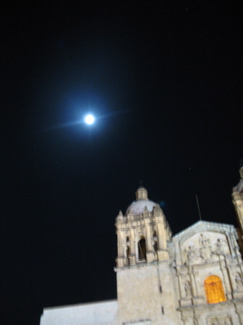
Monday, February 22, 2010
Los de Abajo: The figure of Demetrio Macías
Three Biblical references stand out in part III. The poet Valderrama quotes Genesis 3 (and gives the Latin original), just after Adam and Eve are cast out of the garden (III, I p. 61 “—Los serranos —le dijo con énfasis y solemnidad—son carne de nuestra carne y huesos de nuestros huesos... "Os ex osibus meis et caro de carne mea"... Los serranos están hechos de nuestra madera... De esta madera firme con la que se fabrican los héroes... “).
La lluvia comenzó a caer en gruesas gotas y tuvieron que refugiarse en una rocallosa covacha.
after which she pleads with him not to leave her, suggesting an allusion to Aeneas’ “marriage” to Dido when they take shelter in a cave. All of my copies of The Aeneid, having taken shelter from the exploding hot water heater in my building, are unfortunately inaccessible for comparing the wording. (Note that Camilla is also a character in the Aeneid, leader of the Volscian women warriors.) In light of this description, the opening description of Demetrio’s wife fleeing with the child against the backdrop of the burning house (recalled later in the middle of the novel) evokes (in inversion) Aeneas fleeing burning Troy carrying his father on his back. The emphasis on Demetrio’s son is interesting in this connection. Aeneas must leave Dido, must travel on, though he himself is not destined, nor is his son, to see Rome, the city their descendants will found.
Monday, February 8, 2010
Jorge Luis Borges: Ficciones
Among the “Garden of Forking Paths” stories, I find The Library of Babel, which explores limits of human knowledge and the limits of human knowledge of the limits of knowledge, interesting and funny. And I find The Lottery of Babylon to be ingenious as Borges’ the Company follows a logical sequence of actions that render the inhabitants lives devoid of logic.
I am more drawn, however, to The Circular Ruins, in which “the man” creates a son via dreaming. Though utilizing many ancient philosophical and religious creation concepts, Borges explores poignantly the emotional ties of the creator towards his created. “Circular Ruin” describes the inner process of the creator all the while incorporating references to more impersonal ancient accounts and concepts of Genesis (“the man”- haadam in Genesis 1; sleep – through which the human being is made male and female in Genesis 2; the opening reference to clay alluding to Genesis 2 and the Mesopotamian Atrahasis creation account, to name just three), gnostic/ neoplatonist type concepts of series of lower and lower orders of creation through emanation (the man dreams his creation but learns that he is the creation of a previous creator), and the Christian allusion of father-son imagery. I find the end of the story very touching. Borges depicts the man fearing for his son off on his own, separated from him; and thereby, I would say, depicts the creator poignantly embracing his finitude.
